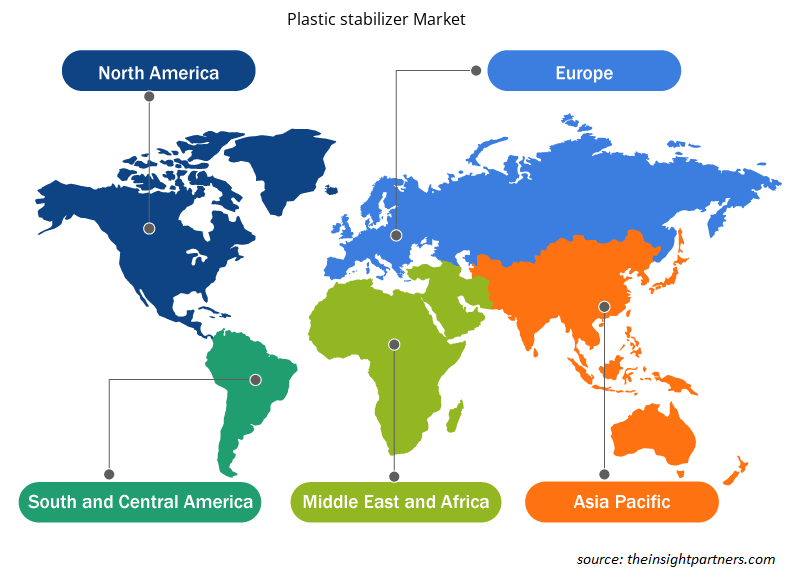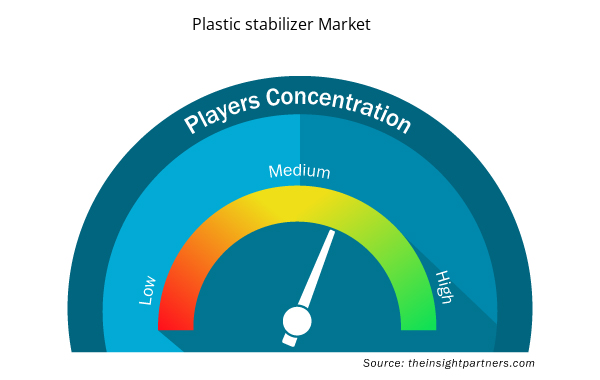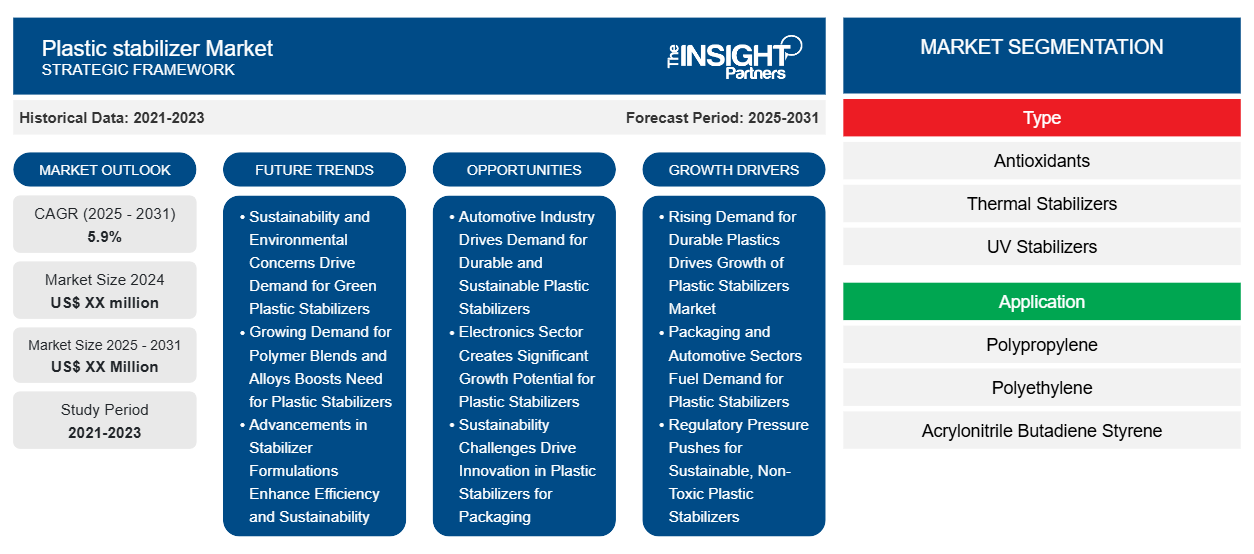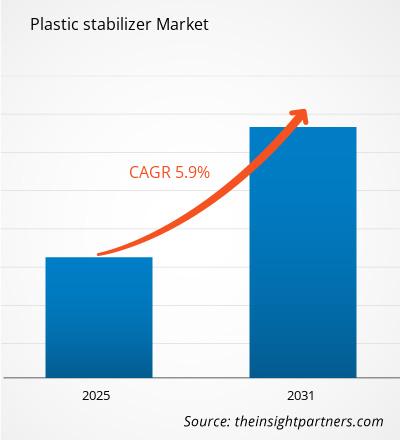Der Markt für Kunststoffstabilisatoren wird voraussichtlich von 2023 bis 2031 eine durchschnittliche jährliche Wachstumsrate (CAGR) von 5,9 % verzeichnen, wobei die Marktgröße von XX Millionen US-Dollar im Jahr 2023 auf XX Millionen US-Dollar im Jahr 2031 wachsen wird.
Der Bericht ist nach Typ (Antioxidantien, Wärmestabilisatoren, UV-Stabilisatoren und andere) segmentiert. Der Bericht ist weiter nach Anwendung segmentiert (Polypropylen, Polyethylen, Acrylnitril-Butadien-Styrol, Polyvinylchlorid (PVC), Polyurethane und andere). Der Bericht ist nach Endverbrauchsbranche segmentiert (Bauwesen, Verpackung, Automobil, Konsumgüter, Elektrik und Elektronik, Landwirtschaft, Medizin und andere). Der Berichtsumfang umfasst fünf Regionen: Nordamerika, Europa, Asien-Pazifik, Naher Osten und Afrika sowie Süd- und Mittelamerika und Schlüsselländer in jeder Region. Die globale Analyse ist weiter auf regionaler Ebene und nach wichtigen Ländern aufgeschlüsselt. Der Bericht bietet den Wert in USD für die oben genannte Analyse und Segmente.
Zweck des Berichts
Der Bericht „Plastic stabilizer Market“ von The Insight Partners zielt darauf ab, die aktuelle Situation und das zukünftige Wachstum sowie die wichtigsten treibenden Faktoren, Herausforderungen und Chancen zu beschreiben. Dies wird verschiedenen Geschäftspartnern Einblicke geben, wie zum Beispiel:
- Technologieanbieter/-hersteller: Um die sich entwickelnde Marktdynamik zu verstehen und die potenziellen Wachstumschancen zu kennen, damit sie fundierte strategische Entscheidungen treffen können.
- Investoren: Durchführung einer umfassenden Trendanalyse hinsichtlich der Marktwachstumsrate, der finanziellen Marktprognosen und der Chancen entlang der Wertschöpfungskette.
- Regulierungsbehörden: Zur Regulierung von Richtlinien und Überwachungsaktivitäten auf dem Markt mit dem Ziel, Missbrauch zu minimieren, das Vertrauen der Anleger zu bewahren und die Integrität und Stabilität des Marktes aufrechtzuerhalten.
Marktsegmentierung für Kunststoffstabilisatoren
Typ
- Antioxidantien
- Thermische Stabilisatoren
- UV-Stabilisatoren
Anwendung
- Polypropylen
- Polyethylen
- Acrylnitril-Butadien-Styrol
- Polyvinylchlorid
- Polyurethane
Endverbrauchsindustrie
- Bauwesen
- Verpackung
- Automobilindustrie
- Konsumgüter
- Elektrik und Elektronik
- Landwirtschaft
- Medizin
Geographie
- Nordamerika
- Europa
- Asien-Pazifik
- Süd- und Mittelamerika
- Naher Osten und Afrika
Geographie
- Nordamerika
- Europa
- Asien-Pazifik
- Süd- und Mittelamerika
- Naher Osten und Afrika
Passen Sie diesen Bericht Ihren Anforderungen an
Sie erhalten kostenlose Anpassungen an jedem Bericht, einschließlich Teilen dieses Berichts oder einer Analyse auf Länderebene, eines Excel-Datenpakets sowie tolle Angebote und Rabatte für Start-ups und Universitäten.
- Holen Sie sich die wichtigsten Markttrends aus diesem Bericht.Dieses KOSTENLOSE Beispiel umfasst eine Datenanalyse von Markttrends bis hin zu Schätzungen und Prognosen.
Wachstumstreiber auf dem Markt für Kunststoffstabilisatoren
- Steigende Nachfrage nach langlebigen Kunststoffen treibt Wachstum des Marktes für Kunststoffstabilisatoren voran: Angesichts der enormen Einsatzmöglichkeiten von Kunststoffen in Branchen wie Automobil, Bauwesen, Verpackung und Konsumgütern zeichnet sich ein Trend zu höherer Haltbarkeit ab, der Umweltbelastungen widersteht. Stabilisatoren wie UV-Stabilisatoren, Antioxidantien und Wärmestabilisatoren dienen dazu, die Haltbarkeit und Leistung des Kunststoffs zu maximieren. Kunststoffstabilisatoren helfen, den durch UV-Licht, Hitze und Oxidation verursachten Kunststoffabbau zu verhindern. So bleiben die Kunststoffprodukte über einen längeren Zeitraum in einem sicheren physikalischen Zustand erhalten. Der aktuelle Trend, langlebige Kunststoffprodukte für den Außenbereich anzubieten, hat sich als einer der entscheidenden Faktoren für das globale Marktwachstum bei Kunststoffstabilisatoren herausgestellt.
- Verpackungs- und Automobilsektor treiben die Nachfrage nach Kunststoffstabilisatoren an: Der Verpackungs- und Automobilsektor ist der größte Verbraucher von Kunststoffstabilisatoren. Da die Menschen immer beschäftigter werden und sich auf E-Commerce und globalen Handel verlassen, steigt die Nachfrage nach stärkeren und attraktiveren Verpackungsmaterialien. Stabilisatoren verhindern das Verblassen von Farben, erhalten die Klarheit und verbessern die mechanischen Eigenschaften von Kunststoffen für Lebensmittel- und Getränkeverpackungen, Kosmetika und Arzneimittel.
- Regulatorischer Druck drängt auf nachhaltige, ungiftige Kunststoffstabilisatoren: Immer mehr Regierungen erlassen strengere und nachhaltigere Richtlinien hinsichtlich des verantwortungsvollen Umgangs mit Chemikalien in Kunststoffprodukten im Hinblick auf Umweltbelange. Beispielsweise zwingen chemische Materialien wie die REACH-Verordnung der Europäischen Union und der Toxic Substances Control Act (TSCA) der US-Umweltschutzbehörde Kunststoffhersteller dazu, Stabilisatoren innerhalb vorgegebener Standards zu verwenden. Daher gibt es einen Trend hin zu ungiftigen oder grünen Stabilisatoren wie biobasierten oder halogenfreien Stabilisatoren. Diese Verordnung dient als Impuls für Innovationen auf dem Markt für Kunststoffstabilisatoren, die nach umweltfreundlicheren und sichereren Lösungen streben.
Markttrends für Kunststoffstabilisatoren
- Nachhaltigkeit und Umweltbedenken treiben die Nachfrage nach umweltfreundlichen Kunststoffstabilisatoren: Umweltbedenken und Nachhaltigkeit werden zunehmend zu wichtigen Einflussfaktoren auf dem Markt für Kunststoffstabilisatoren. Verbraucher, Hersteller und Aufsichtsbehörden verlangen alle Stabilisatoren, die ungiftig, biologisch abbaubar sowie gesundheits- und umweltfreundlich sind. Dies hat zu einem Paradigmenwechsel auf dem Markt für Kunststoffstabilisatoren geführt, der mit der Entstehung umweltfreundlicher Stabilisatoren in Form biobasierter Antioxidantien, UV-Stabilisatoren sowie halogenfreier Stabilisatoren einherging. Noch wichtiger ist, dass diese Alternativen schnell zu den bevorzugten Optionen werden, da die Industrien auf die Erreichung von Nachhaltigkeitszielen hinarbeiten und den ökologischen Fußabdruck ihrer Produkte verringern wollen. Umweltfreundliche Stabilisatoren sind zu einem integralen Bestandteil „grüner“ Kunststoffe geworden, die in verschiedenen Industrien eingesetzt werden.
- Wachsende Nachfrage nach Polymermischungen und -legierungen steigert den Bedarf an Kunststoffstabilisatoren: Der steigende Trend bei der Anwendung von Polymermischungen und -legierungen resultiert aus der gestiegenen Nachfrage sowohl im Automobil- als auch im Bausektor. Solche Polymermischungen kombinieren verschiedene Kunststoffarten, um überlegene Eigenschaften wie erhöhte Festigkeit, Flexibilität sowie Hitze- und UV-Strahlungsbeständigkeit zu erreichen. Kunststoffstabilisatoren sind ein wichtiger Bestandteil solcher Anwendungen und bieten langfristige Stabilität der Polymermischung, indem sie die Polymerketten vor Abbau durch Hitze, UV-Bestrahlung und Oxidation schützen. Mit der zunehmenden Beliebtheit von Polymermischungen und -legierungen steigt auch der Bedarf an Stabilisatoren, die bei unterschiedlichen Arten von Kunststoffformulierungen effizient funktionieren.
- Fortschritte bei Stabilisatorformulierungen verbessern Effizienz und Nachhaltigkeit: Fortschritte bei der Stabilisierungsformulierung tragen ebenfalls dazu bei, ihre Effizienz zu steigern und gleichzeitig ihre Umweltbelastung zu verringern. Zu den Fortschritten gehören die Einführung multifunktionaler Stabilisatoren mit antioxidativen/UV-Schutzeigenschaften und Hochleistungsstabilisatoren, die bei geringerer Konzentration dieselben Ergebnisse erzielen können. Durch die zunehmende Nanotechnologie bei der Formulierung von Stabilisatoren verbessern sich nicht nur die Haltbarkeit und Lebensdauer von Kunststoffen, sondern auch die ästhetischen Qualitäten werden nicht beeinträchtigt. Diese technologischen Trends treiben den Markt tendenziell in Richtung spezialisierterer und effizienterer Lösungen für Stabilisatoren.
Marktchancen für Kunststoffstabilisatoren
- Automobilindustrie treibt Nachfrage nach langlebigen und nachhaltigen Kunststoffstabilisatoren: Der Automobilsektor durchläuft große Veränderungen mit der wachsenden Nachfrage nach leichteren, langlebigen Komponenten, die unter widrigsten Bedingungen funktionieren. Kunststoffstabilisatoren sind ein fester Bestandteil der Herstellung von Automobilkomponenten wie Stoßstangen, Armaturenbrettern, Zierleisten und Karosserieteilen. Mit der Verlagerung der Branche hin zu Elektrofahrzeugen und komplexen Designs gibt es Anzeichen für eine hohe Nachfrage nach Stabilisatoren, die die Wärme- und UV-Stabilität von Kunststoffkomponenten erhöhen. Dieser wachsende Trend zu nachhaltigen Fahrzeugen eröffnet auch Möglichkeiten für den Einsatz umweltfreundlicher Stabilisatoren in Automobilanwendungen.
- Der Elektroniksektor bietet erhebliches Wachstumspotenzial für Kunststoffstabilisatoren: Auch im Elektroniksegment – der Produktion von Smartphones, Laptops, Unterhaltungselektronik und Haushaltsgeräten – war ein schnelles Wachstum zu beobachten. Um den Abbau von Kunststoffen in elektronischen Geräten durch Hitze, UV-Strahlung oder elektrische Leitfähigkeit zu verhindern, ist es unerlässlich, die Integrität von Kunststoffmaterialien unter extremen Betriebsbedingungen aufrechtzuerhalten. Dieser Bereich scheint eine der größten Wachstumschancen für die bei der Herstellung von Kunststoffmaterialien verwendeten Stabilisatoren zu sein. Die zunehmende Komplexität elektronischer Geräte und die steigenden Anforderungen an langlebige und ästhetisch ansprechendere Teile werden die Nachfrage nach speziellen Kunststoffstabilisatoren in der Elektronik vorantreiben.
- Herausforderungen der Nachhaltigkeit treiben Innovationen bei Kunststoffstabilisatoren für Verpackungen voran: Kunststoffstabilisatoren werden in Verpackungsanwendungen häufig eingesetzt. Mit dem zunehmenden Trend zur Nachhaltigkeit werden die Innovation und der Einsatz umweltfreundlicher Stabilisatoren in Verpackungsanwendungen eine große Herausforderung darstellen. Hersteller suchen nach Stabilisatoren, die die Stabilität und Recyclingfähigkeit von Kunststoffverpackungen verbessern können, da Verbraucher und Regierungen Wert auf Abfallreduzierung und recycelbare Materialien legen. Das Wachstum bei Biokunststoffen und kompostierbaren Verpackungsmaterialien wird neue Möglichkeiten für neue Stabilisatorformulierungen schaffen, die mit dieser Art von Material kompatibel sind.
Regionale Einblicke in den Markt für Kunststoffstabilisatoren
Die regionalen Trends und Faktoren, die den Markt für Kunststoffstabilisatoren im Prognosezeitraum beeinflussen, wurden von den Analysten von Insight Partners ausführlich erläutert. In diesem Abschnitt werden auch die Marktsegmente und die Geografie von Kunststoffstabilisatoren in Nordamerika, Europa, im asiatisch-pazifischen Raum, im Nahen Osten und Afrika sowie in Süd- und Mittelamerika erörtert.

- Erhalten Sie regionale Daten zum Markt für Kunststoffstabilisatoren
Umfang des Marktberichts zu Kunststoffstabilisatoren
| Berichtsattribut | Details |
|---|---|
| Marktgröße im Jahr 2023 | XX Millionen US-Dollar |
| Marktgröße bis 2031 | XX Millionen US-Dollar |
| Globale CAGR (2023 - 2031) | 5,9 % |
| Historische Daten | 2021-2022 |
| Prognosezeitraum | 2024–2031 |
| Abgedeckte Segmente | Nach Typ
|
| Abgedeckte Regionen und Länder | Nordamerika
|
| Marktführer und wichtige Unternehmensprofile |
|
Dichte der Marktteilnehmer für Kunststoffstabilisatoren: Verständnis ihrer Auswirkungen auf die Geschäftsdynamik
Der Markt für Kunststoffstabilisatoren wächst rasant, angetrieben durch die steigende Nachfrage der Endverbraucher aufgrund von Faktoren wie sich entwickelnden Verbraucherpräferenzen, technologischen Fortschritten und einem größeren Bewusstsein für die Vorteile des Produkts. Mit steigender Nachfrage erweitern Unternehmen ihr Angebot, entwickeln Innovationen, um die Bedürfnisse der Verbraucher zu erfüllen, und nutzen neue Trends, was das Marktwachstum weiter ankurbelt.
Die Marktteilnehmerdichte bezieht sich auf die Verteilung der Firmen oder Unternehmen, die in einem bestimmten Markt oder einer bestimmten Branche tätig sind. Sie gibt an, wie viele Wettbewerber (Marktteilnehmer) in einem bestimmten Marktraum im Verhältnis zu seiner Größe oder seinem gesamten Marktwert präsent sind.
Die wichtigsten auf dem Markt für Kunststoffstabilisatoren tätigen Unternehmen sind:
- ADEKA Corporation
- Akzo Nobel NV
- Albemarle Corporation
- BASF SE
- Clariant Ltd.
Haftungsausschluss : Die oben aufgeführten Unternehmen sind nicht in einer bestimmten Reihenfolge aufgeführt.

- Überblick über die wichtigsten Akteure auf dem Kunststoffstabilisatormarkt
Wichtige Verkaufsargumente
- Umfassende Abdeckung: Der Bericht deckt die Analyse der Produkte, Dienstleistungen, Typen und Endbenutzer des Kunststoffstabilisator-Marktes umfassend ab und bietet einen ganzheitlichen Überblick.
- Expertenanalyse: Der Bericht basiert auf dem umfassenden Verständnis von Branchenexperten und Analysten.
- Aktuelle Informationen: Der Bericht stellt durch die Abdeckung aktueller Informationen und Datentrends Geschäftsrelevanz sicher.
- Anpassungsoptionen: Dieser Bericht kann angepasst werden, um spezifische Kundenanforderungen zu erfüllen und die Geschäftsstrategien optimal anzupassen.
Der Forschungsbericht zum Markt für Kunststoffstabilisatoren kann daher dabei helfen, die Branchensituation und Wachstumsaussichten zu entschlüsseln und zu verstehen. Obwohl es einige berechtigte Bedenken geben kann, überwiegen die allgemeinen Vorteile dieses Berichts tendenziell die Nachteile.
- Historische Analyse (2 Jahre), Basisjahr, Prognose (7 Jahre) mit CAGR
- PEST- und SWOT-Analyse
- Marktgröße Wert/Volumen – Global, Regional, Land
- Branche und Wettbewerbsumfeld
- Excel-Datensatz



Report Coverage
Revenue forecast, Company Analysis, Industry landscape, Growth factors, and Trends

Segment Covered
This text is related
to segments covered.

Regional Scope
North America, Europe, Asia Pacific, Middle East & Africa, South & Central America

Country Scope
This text is related
to country scope.
Häufig gestellte Fragen
An increase in the use of polymer blends and alloys is expected to be the key market trend.
The report can be delivered in PDF/Word format, we can also share excel data sheet based on request.
On the basis of geography, the plastic stabilizer market is classified into North America, Europe, Asia Pacific, Middle East and Africa, and South and Central America
CLARIANT AG, Syensqo NV, ADEKA CORP, Baerlocher GmbH, BASF SE, L. Brügge¬mann GmbH and Co KG, Evonik Industries AG, Faith Industries LTD, Platinum Industries Ltd, and ALA Polystabs Private Ltd
The major factors driving the plastic stabilizer market are:
1. Rising Demand for Durable and Long-Lasting Plastic Products.
2. Growth in Packaging and Automotive Sectors.
The Plastic stabilizer Market is estimated to witness a CAGR of 5.9% from 2023 to 2031
Trends and growth analysis reports related to Chemicals and Materials : READ MORE..
The List of Companies
- ADEKA Corporation
- Akzo Nobel N.V.
- Albemarle Corporation
- BASF SE
- Clariant Ltd.
- Covestro AG
- Evonik Industries AG
- Solvay S.A.
- SONGWON Industrial Co., Ltd
- The Dow Chemical Company
The Insight Partners performs research in 4 major stages: Data Collection & Secondary Research, Primary Research, Data Analysis and Data Triangulation & Final Review.
- Data Collection and Secondary Research:
As a market research and consulting firm operating from a decade, we have published and advised several client across the globe. First step for any study will start with an assessment of currently available data and insights from existing reports. Further, historical and current market information is collected from Investor Presentations, Annual Reports, SEC Filings, etc., and other information related to company’s performance and market positioning are gathered from Paid Databases (Factiva, Hoovers, and Reuters) and various other publications available in public domain.
Several associations trade associates, technical forums, institutes, societies and organization are accessed to gain technical as well as market related insights through their publications such as research papers, blogs and press releases related to the studies are referred to get cues about the market. Further, white papers, journals, magazines, and other news articles published in last 3 years are scrutinized and analyzed to understand the current market trends.
- Primary Research:
The primarily interview analysis comprise of data obtained from industry participants interview and answers to survey questions gathered by in-house primary team.
For primary research, interviews are conducted with industry experts/CEOs/Marketing Managers/VPs/Subject Matter Experts from both demand and supply side to get a 360-degree view of the market. The primary team conducts several interviews based on the complexity of the markets to understand the various market trends and dynamics which makes research more credible and precise.
A typical research interview fulfils the following functions:
- Provides first-hand information on the market size, market trends, growth trends, competitive landscape, and outlook
- Validates and strengthens in-house secondary research findings
- Develops the analysis team’s expertise and market understanding
Primary research involves email interactions and telephone interviews for each market, category, segment, and sub-segment across geographies. The participants who typically take part in such a process include, but are not limited to:
- Industry participants: VPs, business development managers, market intelligence managers and national sales managers
- Outside experts: Valuation experts, research analysts and key opinion leaders specializing in the electronics and semiconductor industry.
Below is the breakup of our primary respondents by company, designation, and region:

Once we receive the confirmation from primary research sources or primary respondents, we finalize the base year market estimation and forecast the data as per the macroeconomic and microeconomic factors assessed during data collection.
- Data Analysis:
Once data is validated through both secondary as well as primary respondents, we finalize the market estimations by hypothesis formulation and factor analysis at regional and country level.
- Macro-Economic Factor Analysis:
We analyse macroeconomic indicators such the gross domestic product (GDP), increase in the demand for goods and services across industries, technological advancement, regional economic growth, governmental policies, the influence of COVID-19, PEST analysis, and other aspects. This analysis aids in setting benchmarks for various nations/regions and approximating market splits. Additionally, the general trend of the aforementioned components aid in determining the market's development possibilities.
- Country Level Data:
Various factors that are especially aligned to the country are taken into account to determine the market size for a certain area and country, including the presence of vendors, such as headquarters and offices, the country's GDP, demand patterns, and industry growth. To comprehend the market dynamics for the nation, a number of growth variables, inhibitors, application areas, and current market trends are researched. The aforementioned elements aid in determining the country's overall market's growth potential.
- Company Profile:
The “Table of Contents” is formulated by listing and analyzing more than 25 - 30 companies operating in the market ecosystem across geographies. However, we profile only 10 companies as a standard practice in our syndicate reports. These 10 companies comprise leading, emerging, and regional players. Nonetheless, our analysis is not restricted to the 10 listed companies, we also analyze other companies present in the market to develop a holistic view and understand the prevailing trends. The “Company Profiles” section in the report covers key facts, business description, products & services, financial information, SWOT analysis, and key developments. The financial information presented is extracted from the annual reports and official documents of the publicly listed companies. Upon collecting the information for the sections of respective companies, we verify them via various primary sources and then compile the data in respective company profiles. The company level information helps us in deriving the base number as well as in forecasting the market size.
- Developing Base Number:
Aggregation of sales statistics (2020-2022) and macro-economic factor, and other secondary and primary research insights are utilized to arrive at base number and related market shares for 2022. The data gaps are identified in this step and relevant market data is analyzed, collected from paid primary interviews or databases. On finalizing the base year market size, forecasts are developed on the basis of macro-economic, industry and market growth factors and company level analysis.
- Data Triangulation and Final Review:
The market findings and base year market size calculations are validated from supply as well as demand side. Demand side validations are based on macro-economic factor analysis and benchmarks for respective regions and countries. In case of supply side validations, revenues of major companies are estimated (in case not available) based on industry benchmark, approximate number of employees, product portfolio, and primary interviews revenues are gathered. Further revenue from target product/service segment is assessed to avoid overshooting of market statistics. In case of heavy deviations between supply and demand side values, all thes steps are repeated to achieve synchronization.
We follow an iterative model, wherein we share our research findings with Subject Matter Experts (SME’s) and Key Opinion Leaders (KOLs) until consensus view of the market is not formulated – this model negates any drastic deviation in the opinions of experts. Only validated and universally acceptable research findings are quoted in our reports.
We have important check points that we use to validate our research findings – which we call – data triangulation, where we validate the information, we generate from secondary sources with primary interviews and then we re-validate with our internal data bases and Subject matter experts. This comprehensive model enables us to deliver high quality, reliable data in shortest possible time.


 Holen Sie sich ein kostenloses Muster für diesen Bericht
Holen Sie sich ein kostenloses Muster für diesen Bericht